
The Murray River
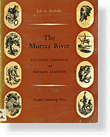 This information was reproduced from the Oxford University Press, published 1960. This information was reproduced from the Oxford University Press, published 1960.
Some content has been modified to make it current with today's climate and circumstances along the Murray River.
Australia is not a land of big rivers, as many countries are, and some of the rivers marked on the map behave very differently from English rivers. Many of those marked in the centre of Australia never reach the sea at all. They flow down from the hills inland until they dry up altogether in the not, dry deserts. Rivers such as Cooper’s Creek and the Diamantina do not , n fact, have any water in them at all for the greater part of the year. After there has ben heavy rain, water flows along the rivers for a few weeks; but before long it dries up, leaving behind it sandy river beds with little lakes at intervals. About every ten years in Australia there is practically no rain in this area all the year, and then even the little lakes dry up.
Another strange thing about the inland waters is that, except after rain, the water in them tastes very salty, like sea-water. This is because the hot sun draws the moisture up from the earth, and leaves the salt behind. And so more and more salt collects on the surface. For instance, the great Lake Eyre marked on the map is really nothing more than an enormous area of salty mud with salty pools here and there; only very rarely does if fill with water.

Australia has, however, one very big river. It is the Murray River in the south-east part of the continent. The Murray is seven or eight times as long as the Thames, and all the little streams and rivers in an area as big as Frances and Germany together flow soon or later into the Murray.
The Murray rises in the Australian Alps, in the south-east corner of Australia, and it flows in a great arc until it reaches a shallow lake and then the sea near the city of Adelaide a distance of over 1,600 winding miles. It has two very big tributaries which flow into it from the north. One of these, the Murrumbidgee, also flows down from the Alps; the other and longer, the Darling, flows a very long way down from the north, through flat, hot, dry country, and often has very little water in it.
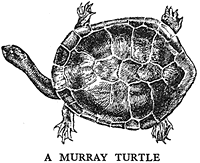 A big river like the Murray would be important in any country, but in a hot, dry country like Australia it is particularly important. It brings so much water down from the mountains that it is only in an exceptionally dry year that the river runs low. And so all hot, dry lands through which the Murray and its tributaries run can be watered from the rivers and made to grow some of Australia’s most valuable crops. This part of Australia, consists of the State of Victoria, much of New South Wales and part of South Australia, is sometimes called the ‘Fertile Crescent’, and by far the greatest number of Australians live in it. A big river like the Murray would be important in any country, but in a hot, dry country like Australia it is particularly important. It brings so much water down from the mountains that it is only in an exceptionally dry year that the river runs low. And so all hot, dry lands through which the Murray and its tributaries run can be watered from the rivers and made to grow some of Australia’s most valuable crops. This part of Australia, consists of the State of Victoria, much of New South Wales and part of South Australia, is sometimes called the ‘Fertile Crescent’, and by far the greatest number of Australians live in it.
Until a short time ago, before good roads and railways had been built, the river was also very important as a way of travelling and carrying goods form one part of the country to another. Hundreds of paddle steamer and their barges chugged up and down the slow river, carrying goods and people.
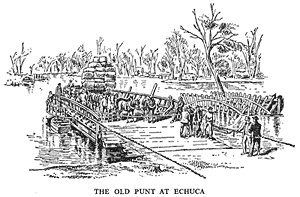 The first white people to settle in Australia towards end of the eighteenth century settled on the coast mostly in or near the sheltered harbour of Sydney, on the eastern side of the Australian Alps. They hardly travelled inland at all, and they knew nothing of what lay behind them. The first white people to settle in Australia towards end of the eighteenth century settled on the coast mostly in or near the sheltered harbour of Sydney, on the eastern side of the Australian Alps. They hardly travelled inland at all, and they knew nothing of what lay behind them.
When white men had been living in Australia for some thirty years, the settlers in Sydney began to want more pasture for their cattle and sheep, and so they began to explore inland. No one had any idea that the country would be like. It might be dense jungle or parched desert. There might be dangerous wild animals and fierce bands of natives. No one knew, but there are always men bold and adventurous enough to take the risk. Two of these explorers, Hamilton Hume and William Hovel, where the first white men to discover the lovely snow-topped Australian Alps, when they were travelling from Sydney down to the great Southern Ocean in the year 1824.
These were the first mountains they had found in Australia, and they were very much excited about them. But they were more interested in reaching the sea than in crossing mountains, and so they passed by the Alps on their inland side. About a week later, they came across the Murray at a place where the town of Albury now stands. They were the first white men, therefore, to discover the river, they called it the Hume River.
The river was wide and deep, because a great deal of water was coming down from the mountains, and Hume and Hovell had to find a way of crossing it. They tramped downstream and upstream through the rich, high grass along its banks, searching for a spot where the banks of the river were less steep and the water not so deep. When at last they found a possible place, they built a raft with branches and a tarpaulin, and got across safely. Then they found their way down through the hilly, fertile country to Port Phillip on the coast, where Melbourne now stands.
Others soon followed, and cattle farmers began to set up cattle stations near the river there there was plenty of water to make the grass grow and to water their animals. The first cattle station, called Mungabareena, was where Albury now stands, and the second, called Wodonga, was on the other side of the river for at this place the river was side and shallow, and therefore easy to cross. Soon a store-keeper opened a little shop on the banks of the river to serve the cattle-men; Albury had begun.
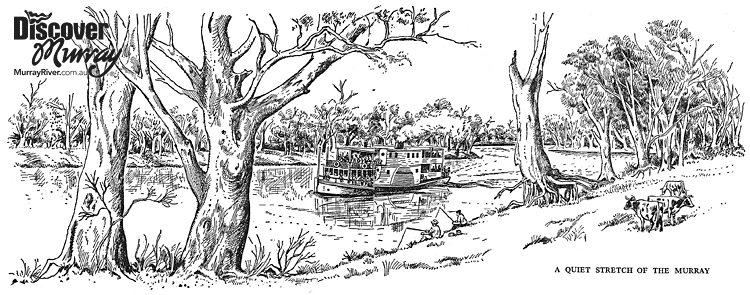
Other farmers began cattle stations and sheep runs farther north along the banks of the Murray’s big tributary, the Murrumbidgee, and in the country between; but no one had followed the rivers westward and so no one knew where they flowed to.
A few years after Hume and Hovell had returned to Sydney, Captain Charles Sturt was sent with a team of men to find out where the Murrumbidgee went to. Sturt, deciding that it might prove easier to travel by water, took a small open boat with him from Sydney on a cart, and in this he and seven of this men set off into unknown land. Nothing out of the ordinary happened for the first week, except that the mosquitoes worried them, and dingoes (wild dogs) prowled round their camp at night. Bands of natives, the Aborigines, followed them out of curiosity, but did them no harm. Then, quite suddenly, as they were floating with the current down the Murrumbidgee, they turned round a big sweep into what they called ‘a broad and noble river’. Sturt named it the Murray River, after Sir George Murray, an important Englishmen he admired.
The men were far too excited by their discovery to turn back. They travelled on for another 200 miles, and then, just past where the town of Mildura now stands, they discovered that another great river, the River Darling, joins the Murray. Sand brought down by the Darling had formed a long sand-bank reaching out into the Murray, and there was not much room to get through. This was the land of the Murray River Aboriginies, who were a very fierce tribe. As Sturt’s boat came near the sand-bank, a band of natives, waving their spears and shouting war-cries, sprang into view on the bank. Fortunately a friendly native called them off, and Sturt’s boat passed safely by.
It took them three more weeks to reach the mouth of the river, a thousand miles away, and by this time their food was beginning to get very short. When they did reach te mouth of the river they found that, instead of running into the sea, it ran into a shallow lake (Lake Alexandrina). There was nothing to do except turn round and go back. It was the middle of summer and fiercely hot. Rations got down to a pound of flour a day – enough to make each mand one big scone. Some of the men would have given up and allowed themselves to die, but Sturt ordered them to keep on.
It was much harder work going upstream than floating down. They rowed, they pulled the boat with ropes, they pushed it through the shallow parts. Sturt got so exhausted he went temporarily blind, and all of them became weak with starvation. It took them two months to get back, and when fresh food reached them, they had just eaten the last mouthful of what they had. None of them ever forgot the Murray. Captain Sturt published a book in London about the Murray, and that encouraged a group of people in the idea of building a big city near its mouth, later named Adelaide.
Some years later, when Adelaide had just ben established, some Sydney farmers asked Sturt if he would drove sheep and cattle overland to sell in Adelaide, where food was short. It was just the kind of job that Sturt liked, and he agreed. The cattle and sheep were mustered on the banks of the river near Albury, and there Sturt and his party took them over. The river at Albury was still called Hume, though Sturt suspected that it was, in fact, the same river which he found on his earlier journey; now he would be able to find out. He would follow the river all the way. For four months they walked 1,400 miles beside the slow waters of the huge river, passing the places where the Murrumbidgee joins the Murray and, later, the Darling. At last they arrived in Adelaide, bringing fresh meat from the animals they had driven and the welcome news that the Murray was a safe overland route from east to west. But in fact they were not the first overlanders; two other men had beaten them by four months.
Sturt was then asked to have another look at the mouth of the Murray, and see whether it would be suitable for a port. After exploring it thoroughly, he reported that he was unable to find a safe anchorage there.
The early settlers in Australia nearly all settled near the sea, mostly in Sydney, Melbourne, and Adelaide. Between these three new towns there were no roads, not even tracks, and a man could easily die from thirst on the long, hot, trackless journeys between them. If they travelled along the Murray, however, travellers could get fresh water all the time, food and drink for them animals, and a marked road that they could not lose. And so whenever they could they followed the river. Small settlements and lonely farms began to spring up along its banks wherever there was a good patch of soil or enough grass for sheep to graze on.
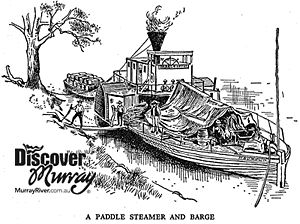 Wherever men settlements there had to be stores and food, and ways of getting them from one place to another. It was easiest to carry them on boats along the river, and soon traders taking goods on small boats to the farms, and bringing back to the towns their skins and wool and their crops. More than 150 years ago, in 1853, an adventurous young man, William Randell, who lived not far from a little town called Mannum (South Australia) on the banks of the river, built and sailed the very first paddle steamer ever to appear on the Murray; he called her the Mary Ann. At top speed her one and only boiler, a square iron box, used to bulge dangerously, and the crew had to put chains round it, packed with wood, to stop it exploding. But Randell steamed in the Mary Ann about 1,000 miles up the river, to the town of Echuca (Victoria), and back. Wherever men settlements there had to be stores and food, and ways of getting them from one place to another. It was easiest to carry them on boats along the river, and soon traders taking goods on small boats to the farms, and bringing back to the towns their skins and wool and their crops. More than 150 years ago, in 1853, an adventurous young man, William Randell, who lived not far from a little town called Mannum (South Australia) on the banks of the river, built and sailed the very first paddle steamer ever to appear on the Murray; he called her the Mary Ann. At top speed her one and only boiler, a square iron box, used to bulge dangerously, and the crew had to put chains round it, packed with wood, to stop it exploding. But Randell steamed in the Mary Ann about 1,000 miles up the river, to the town of Echuca (Victoria), and back.
Another man, Captain Francis Cadell, who had been in the Royal Navy, made a long trip up the Murray in a canvas boat in 1852. Having discovered what the river was like, he ordered a proper paddle steamer to be built for him in Sydney. This was the Lady Augusta, a much bigger and better boat than the Mary Ann, and Captain Cadell took it even farther up the river than Echuca, passing the Mary Ann on the way. On his journey back, he towed a barge heavily loaded with wool for market in Adelaide, which was by this time growing into a big town. A little later another steamer went up as far as the town of Albury, beyond which the river is not navigable. After this the river was used regularly as the quickest and cheapest way of travelling and carrying goods.
The next fifty years were very exciting years on the river. Gold had just been discovered in several places not far from the Murray, and men were rushing to the mines to make their fortunes. Hundreds of steamers and barges went up and down the river, carrying eager people on their way to the mines, carrying their food and other things they needed, and carrying back cargoes of wheat and wool to the markets of Adelaide.
These paddle steamers were mostly double-deckers, looking rather like small houses; in fact, many of them have not been brought by people who have tied them up along the banks of the river and use them as houses, especially holiday houses. They had blunt noses, noisy, thumping engines and big paddle-wheels. Their hulls were built of red-gum wood, which will not rot in water, with a top usually made of iron. They were painted in bright colours, and often had canvas awnings to keep out the strong sunlight. The biggest and richest of them had three decks, refrigerators, hot water, and electric light, luxuries which their hundred or so passengers where enjoying long before the towns along the river had them.
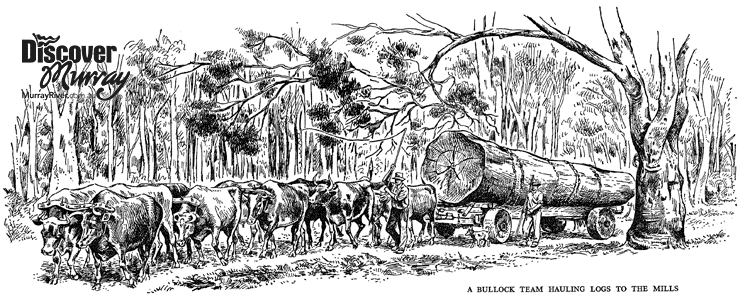
While the paddle steamers were carrying on this very valuable trade along the river, enterprising engineers were beginning to build railways to compete with the paddle steamers. The railway owners wanted farmers to send their wool and cattle by rail instead of by river; and they pointed out to the farmers that, as the way to the cities was much shorter by rail, the goods would get there much quicker. The trains would take the goods to Melbourne, where people would pay higher prices than they would in Adelaide, where the steamers’ cargoes were sent. Finally, the railway owners offered cheaper rates for carrying goods than the paddle-steamer owners could. So the farmers began using the railways more and more, and the steamers less and less, until at last almost all of the steamers stopped running.
The Murray is not really a good river for shipping. In the first place the big, shallow lake at its mouth, Lake Alexandrina, was, until 1940, always being blocked up by the sand that the sea washes into it. A captain sailing his steamer into the Murray had great difficulty in finding a way through these moving banks of sand. The river, even when it is in flood runs too slowly through is so level. In fact, you can walk faster than the river flows.
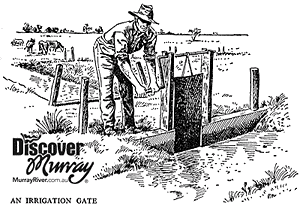 In years of drought the Murray in places gets very low, and there is not enough water to carry the ships. In very dry years it has been known to shrink until in places it was no wider than a city pavement; you could step over it. Travellers on horseback would come across a full-sized steamer stranded in the middle of a billabong that used to be part of the river. And there it had to stay until the heavy rains came again, and the river filled up enough to float the ship. At other times the Murray floods badly. In 1956 there were exceptionally heavy rains, and all the tributaries of the Murray brought down a vast amount of extra water. The river spread until in places it was twenty miles wide. When floods like that happened, the ships’ captains had to tie up somewhere safe and wait for the floods to subside. In years of drought the Murray in places gets very low, and there is not enough water to carry the ships. In very dry years it has been known to shrink until in places it was no wider than a city pavement; you could step over it. Travellers on horseback would come across a full-sized steamer stranded in the middle of a billabong that used to be part of the river. And there it had to stay until the heavy rains came again, and the river filled up enough to float the ship. At other times the Murray floods badly. In 1956 there were exceptionally heavy rains, and all the tributaries of the Murray brought down a vast amount of extra water. The river spread until in places it was twenty miles wide. When floods like that happened, the ships’ captains had to tie up somewhere safe and wait for the floods to subside.
About the time that the railways were taking the place of the steamers for transport, people were beginning to realise that the river water could be put to a much better use watering the dry land when there was not enough rain, and making it possible to grow crops. And so they began to discuss schemes for using the water of the Murray for irrigation, and for building dams and reservoirs to store the water. But it was not easy to get everybody to see the importance of dams and reservoirs, and for a long time nothing was done. Then, in 1902, the Australian Government finally decided that it would be best for the country as a whole to use the river for irrigation rather than for transport.
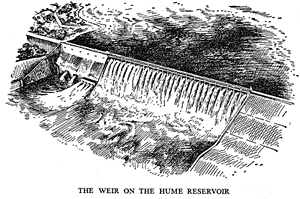 Some years earlier two Canadian engineers, the Chaffey brothers, had come to Australia to experiment with schemes for drawing water from the river to irrigate the fields for farming. They started by testing the soil near Mildura, close to where the Darling joins the Murray, and they discovered that if the soil could be watered, it would be very suitable for growing vines. So they dug irrigation channels and set up pumps to lift the water into the channels. Then they planted their vines. Other farmers began to do the same sort of thing, but sometimes there was not enough water for them all. Some years earlier two Canadian engineers, the Chaffey brothers, had come to Australia to experiment with schemes for drawing water from the river to irrigate the fields for farming. They started by testing the soil near Mildura, close to where the Darling joins the Murray, and they discovered that if the soil could be watered, it would be very suitable for growing vines. So they dug irrigation channels and set up pumps to lift the water into the channels. Then they planted their vines. Other farmers began to do the same sort of thing, but sometimes there was not enough water for them all.
So the Government decided to build an enormous reservoir to store the water in the wet years so that there should be no shortage in the dry years. The reservoir was made near Albury, just at the place where Hume and Hovell had first crossed the river more than a hundred years earlier, and it was called the Hume Reservoir. A huge, high, concrete wall was built across the wide river a long way out on each side. Then the water, held up by the wall, spread out all round to make an enormous lake. Gates were built in the walls so that when there is enough water in the reservoir, the gates can be opened to allow the rest of the water to flow down the river. In dry years, when not much water is coming down from the mountains, the water in the reservoir can be used. The reservoir holds so much water that if it did not rain for two years, there would still be enough to keep the river flowing.
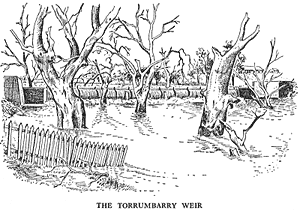 About 145 miles farther down the river another dam, or great wall, called the Yarrawonga Weir, had ben built to form another lake. Before the Yarrawonga Weir was built, the summer sun used to dry up all the crops, and farmers could grown only poor grass or crops which need very little moisture. Now, the water from the lake is carried in a series of irrigation ditches like small canals, getting smaller and smaller until they reach all the fields and orchards. And so the farmers can grow fruit, vegetables, and wheat, and rich grass and hay for their dairy cattle, fat lambs, and pigs. In one place there are orange orchards, and the water is sprayed over the orange trees with huge sprays. In another area even rice is grown – and rice needs more water than any crop. About 145 miles farther down the river another dam, or great wall, called the Yarrawonga Weir, had ben built to form another lake. Before the Yarrawonga Weir was built, the summer sun used to dry up all the crops, and farmers could grown only poor grass or crops which need very little moisture. Now, the water from the lake is carried in a series of irrigation ditches like small canals, getting smaller and smaller until they reach all the fields and orchards. And so the farmers can grow fruit, vegetables, and wheat, and rich grass and hay for their dairy cattle, fat lambs, and pigs. In one place there are orange orchards, and the water is sprayed over the orange trees with huge sprays. In another area even rice is grown – and rice needs more water than any crop.
Farther down the river there are two more big reservoirs. One of these, the Torrumbarry, was made in a valley where hundreds of big gum-trees were growing. The trees soon died from standing in deep water; but red-gum wood is so hard that it never rots, and so the dead trees still stand, their trunks showing the level as the water drops.
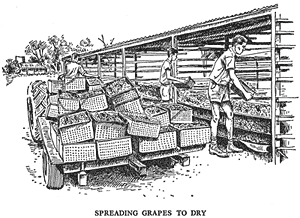 The farmers near these reservoirs grow mostly fruit. A great many grapes are grown, some for drying to make raisins, sultanas, and currents, and others for making wine. There are orange, grapefruit, and lemon orchards, and also a great many apricots. The fruit ripens soon after Christmas, which is summer-time in Australia. Then it is sent to England and other countries in Europe, and arrives when the European fruit season is over. The farmers near these reservoirs grow mostly fruit. A great many grapes are grown, some for drying to make raisins, sultanas, and currents, and others for making wine. There are orange, grapefruit, and lemon orchards, and also a great many apricots. The fruit ripens soon after Christmas, which is summer-time in Australia. Then it is sent to England and other countries in Europe, and arrives when the European fruit season is over.
There are several other smaller dams along the Murray from the town of Mildura to the sea, and the purpose of these is to control the flow of water so that there should never be either too little or too much.
Let us now take a trip down the 1,600 miles or more of the Murray from where it rises as a tiny stream in the mountains to where it finally flows into Lake Alexandrina near Adelaide, and then into the sea.
The Murray rises near the highest mountain in Australia, Mount Kosciusko (pronounced Kozzy-us-co), which is about twice as high as any British mountain. The highest mountains in the Australian Alps are covered with snow for about half the year. This is one of the few places where Australians can see snow. As the Murray flows down the mountains it is joined by other streams, all carrying the melted snow in rushing torrents through rocky, steep-walled valleys. So much moisture makes the mountain plants and grasses grow rich and green and the forest trees grow large. There are widely scattered cattle and sheep farms. The winters are cold, but in the warm summers farmers from the lowlands drive their cattle and sheep up the mountains to grow fat on the good grass.
By the time the Murray has flowed 200 miles through the mountains down to the town of Albury, it has grown into a big river. Albury used to be the meeting-place for the early cattle farmers, because here the river was shallow and could be crossed. Now it is an important junction for the railways running to Melbourne and Sydney. The main highway from Melbourne to Sydney crosses the Murray by a long wooden bridge. Albury is a fine city with wide streets and houses set in lovely lawns and gardens, or there is always plenty of water to keep the gardens green. The farmers from miles round bring their animals to the saleyards at Albury, and their are woollen-mills and flour-mills and factories for dealing with meat and skins.
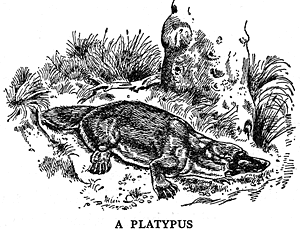 The river banks near Albury and along much of its course are lined by dark-green gum-trees stretching some fifty feet straight up into the sky. Sometimes grey, dead trees stand like ghosts by the river; sometimes a great tree has fallen into the river, making the water swirl round it. From Albury the river runs down into very flat country with nothing but wide, flat plains as far as the eye can see. The soil is reddish-brown; the climate is warm and sunny, and it seldom rains. The river banks are low, making it easy to draw up water to irrigate the fields; so near the river there are many small farms growing vines and various crops an keeping dairy cows. Farther from the river in the dry plains the widely scattered farms are mainly wheat and sheep farms. The river banks near Albury and along much of its course are lined by dark-green gum-trees stretching some fifty feet straight up into the sky. Sometimes grey, dead trees stand like ghosts by the river; sometimes a great tree has fallen into the river, making the water swirl round it. From Albury the river runs down into very flat country with nothing but wide, flat plains as far as the eye can see. The soil is reddish-brown; the climate is warm and sunny, and it seldom rains. The river banks are low, making it easy to draw up water to irrigate the fields; so near the river there are many small farms growing vines and various crops an keeping dairy cows. Farther from the river in the dry plains the widely scattered farms are mainly wheat and sheep farms.
A quiet visitor to the river at dusk might very likely see a platypus leave his burrow in the river bank and come out to feed. Largely the platypus has moved away from the Murray River due to pollution. A platypus is not unlike a beaver, except for his wide, flat beak and his webbed feet. He is about twenty inches long and is covered in soft brown fur. He eats worms and insects which he digs out of the mud with his beak and the sharp claws on his webbed feet. He is very shy, and if he hears anyone move, he will slip back into the water and swim very fast to his burrow. His burrow is a long narrow tunnel, perhaps fifty fee long, which leads to a small opening where the female platypus lays her two or three eggs. Platypuses, like kangaroos, keep their babies in a pouch on their mother’s body for the first few weeks. Also, like kangaroos, they are found only in Australia.
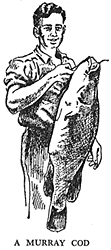 After flowing some 482 kilometres (300 miles) the river reaches Echuca, another town which grew up at a point on the river where there was a possible crossing. One of the earliest bridges across the Murray was built here and, in the days of coaching, the Cobb and Co. coaches crossed the river by this bridge. The steamers also came up to Echuca to prick up cargoes of wool. Then it was an important town; now it is mainly a holiday place. After flowing some 482 kilometres (300 miles) the river reaches Echuca, another town which grew up at a point on the river where there was a possible crossing. One of the earliest bridges across the Murray was built here and, in the days of coaching, the Cobb and Co. coaches crossed the river by this bridge. The steamers also came up to Echuca to prick up cargoes of wool. Then it was an important town; now it is mainly a holiday place.
From Echuca the river flows 320 kilometres (200 miles) north-westwards to the town of Swan Hill through a country full of lakes, swamps, and billabongs, where there are many dairy farms. Thee is good fishing in this region. The best of Australian river fish, the Murray Cod, is caught here, and fishermen sometimes catch enormous Murray Cod – even as big as a man. Murray Turtles are also often to be seen. These are like tortoises but with webbed feet. They can stay under water for a long time on end, and they also often lie out on the mud for hours. They lay their eggs in the mud and let the heat of the sun hatch them.
Swan Hill is an important market town for all the produce from the land irrigated from the Torrumbarry reservoir. It is also a good stopping-place for travellers and holiday-makers journeying along the Murray Valley in cars or buses. There is a bridge across the river at Swan Hill.
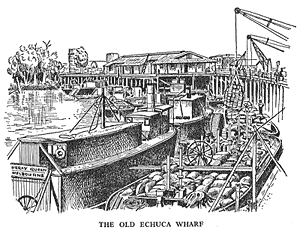 West of Swan Hill lies the Mallee country, much of which is practically desert with occasional dust-storms of fine red dust. It is called Mallee because the only kind of trees which generally grow there naturally is mallee scrub, a stunted tree growing only about eight free high. The mallee has no main trunk but several stems growing from the roots, bearing dull, grey-green, leathery leaves. West of Swan Hill lies the Mallee country, much of which is practically desert with occasional dust-storms of fine red dust. It is called Mallee because the only kind of trees which generally grow there naturally is mallee scrub, a stunted tree growing only about eight free high. The mallee has no main trunk but several stems growing from the roots, bearing dull, grey-green, leathery leaves.
Along the river valley there are farms growing grapes and oranges and lemons which are watered by irrigation. But beyond the reach of the irrigation there is practically no farming at all because it is too hot and dry. Farmers keep a very few sheep to graze the scanty grass, and some farmers cultivate and fertilise their paddocks because in the occasional years when there is enough rainfall good crops of wheat can be grown.
The Murray runs on westward through the Mallee country, past where the Murrumbidgee joins it, and past the great weir built after the Second World War to provide water for the Robinvale irrigated orchards. At last it comes to the important city of Mildura. Before irrigation all the country around Mildura was very poor. Now Mildura is the centre of prosperous farms, orchards, and vineyards depending on the vast amount of water pumped from the river by the many pumping station. One of Mildura’s pumping stations, at Red Cliffs (named because of the red colour of the soil), is the largest in all Australia.
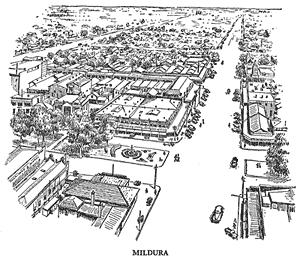 As well as pumping water on to their fields, farmers in the Mallee country have to drain away to spare water. If they did not, it would sink deep into the sub-soil, where there is a layer of salt, and dissolve the salt. Then, as more water soaked into the ground, the salt would rise and kill the vines. As well as pumping water on to their fields, farmers in the Mallee country have to drain away to spare water. If they did not, it would sink deep into the sub-soil, where there is a layer of salt, and dissolve the salt. Then, as more water soaked into the ground, the salt would rise and kill the vines.
The vines are grown in rows trained on wires. In front of each row runs an irrigation ditch which is filled with water when the gates controlling the water are opened. The grapes ripen in the summer sun. When they are picked, some kinds are made into wine, but most are laid out to dry in the hot sun and are then taken to the packing sheds. This is a very busy time of year, and there may be as many as 600 men and women at work in a single packing-shed.
Most of the farms are fairly small. The white houses of the farmers, the brick-red soil, the low, grey drying-and packing-sheds, the green rows of vines, the glossy green and yellow of citrus-fruit orchards, and the hot, brilliant sun give the countryside round Mildura colour and character. Mildura itself is a fine town and, like so many Australian towns, it has wide streets planted with gum-trees and palms, and fine parks.
Between Mildura and Murray Bridge there are several more well-laid-out towns which are visited by many holiday-makers travelling up the Murray Valley. Most important is Renmark, in the Lake Victoria irrigation area, there there is another of the comparatively few bridges that cross the river. This is the second to last bridge before the Murray Bridge, nearly 482 kilometres (300 miles) away. At the old town of Morgan, where the river takes a sharp bend southwards, there are pipelines which carry water from the river hundreds of miles out to small towns in the arid regions of South Australia. Another pipeline carries Murray water from Mannum to help supply the city of Adelaide. The river between Mildura and Murray Bridge flows for much of the way through gorges with steep sides.
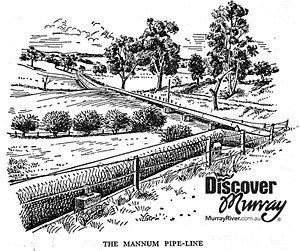 The last 160 kilometres (100 miles) of the Murray Valley used to be swampy, but now it has been drained, and banks have been built up to prevent the river from flooding. The flat, drained land, which can be watered from the river during the summer, grows rich grass on which feed large herds of dairy cows and flocks of fattening lambs. The last 160 kilometres (100 miles) of the Murray Valley used to be swampy, but now it has been drained, and banks have been built up to prevent the river from flooding. The flat, drained land, which can be watered from the river during the summer, grows rich grass on which feed large herds of dairy cows and flocks of fattening lambs.
The town of Murray Bridge is named after the big bridge which carries the main road from Melbourne to Adelaide. All the farmers’ milk and wheat and wool is sent into Murray Bridge, where there are butter and cheese factories, mills to grind the wheat, and storehouses to hold the wool ready for the auction sales in Adelaide.
Where the great river finally reaches the sea there used to be sand-banks and swamps. Although the river is so big, it has flowed or so many miles through flat country that is moves very slowly and has not enough force to hold back the sea, which at high tide used to travel up the river, carrying salt and sand. Now five great walls called barrages, have been built between the sandy islands in Lake Alexandrina. These barrages have gates in them which at high tide are shut tight to keep the sea water back, and at low tide are opened to let the river water escape to the sea.
Now that the people of Australia have learnt how to manage their great river from its source to its mouth, and to make the best use of it’s valuable waters, it provides prosperity for more and more people. even as far away as England people should be grateful to the Murray River when they enjoy Australian butter and cheese, Australian fruits, and Australian wines.
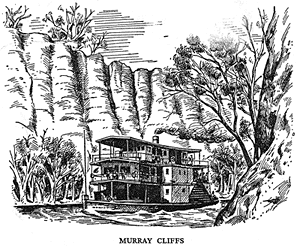 |
Some other topics of interest:
|
|








 A Celtic Christmas by A Taste Of Ireland
A Celtic Christmas by A Taste Of Ireland DREAMS FLEETWOOD MAC & STEVIE NICKS SHOW
DREAMS FLEETWOOD MAC & STEVIE NICKS SHOW The Royal Edinburgh Military Tattoo 2023 - Arts On Screen
The Royal Edinburgh Military Tattoo 2023 - Arts On Screen Angove Family Winemakers Art Exhibition featuring Wendy Neal
Angove Family Winemakers Art Exhibition featuring Wendy Neal
 This information was reproduced from the Oxford University Press, published 1960.
This information was reproduced from the Oxford University Press, published 1960.
 A big river like the Murray would be important in any country, but in a hot, dry country like Australia it is particularly important. It brings so much water down from the mountains that it is only in an exceptionally dry year that the river runs low. And so all hot, dry lands through which the Murray and its tributaries run can be watered from the rivers and made to grow some of Australia’s most valuable crops. This part of Australia, consists of the State of Victoria, much of New South Wales and part of South Australia, is sometimes called the ‘Fertile Crescent’, and by far the greatest number of Australians live in it.
A big river like the Murray would be important in any country, but in a hot, dry country like Australia it is particularly important. It brings so much water down from the mountains that it is only in an exceptionally dry year that the river runs low. And so all hot, dry lands through which the Murray and its tributaries run can be watered from the rivers and made to grow some of Australia’s most valuable crops. This part of Australia, consists of the State of Victoria, much of New South Wales and part of South Australia, is sometimes called the ‘Fertile Crescent’, and by far the greatest number of Australians live in it. The first white people to settle in Australia towards end of the eighteenth century settled on the coast mostly in or near the sheltered harbour of Sydney, on the eastern side of the Australian Alps. They hardly travelled inland at all, and they knew nothing of what lay behind them.
The first white people to settle in Australia towards end of the eighteenth century settled on the coast mostly in or near the sheltered harbour of Sydney, on the eastern side of the Australian Alps. They hardly travelled inland at all, and they knew nothing of what lay behind them.
 Wherever men settlements there had to be stores and food, and ways of getting them from one place to another. It was easiest to carry them on boats along the river, and soon traders taking goods on small boats to the farms, and bringing back to the towns their skins and wool and their crops. More than 150 years ago, in 1853, an adventurous young man, William Randell, who lived not far from a little town called Mannum (South Australia) on the banks of the river, built and sailed the very first paddle steamer ever to appear on the Murray; he called her the Mary Ann. At top speed her one and only boiler, a square iron box, used to bulge dangerously, and the crew had to put chains round it, packed with wood, to stop it exploding. But Randell steamed in the Mary Ann about 1,000 miles up the river, to the town of Echuca (Victoria), and back.
Wherever men settlements there had to be stores and food, and ways of getting them from one place to another. It was easiest to carry them on boats along the river, and soon traders taking goods on small boats to the farms, and bringing back to the towns their skins and wool and their crops. More than 150 years ago, in 1853, an adventurous young man, William Randell, who lived not far from a little town called Mannum (South Australia) on the banks of the river, built and sailed the very first paddle steamer ever to appear on the Murray; he called her the Mary Ann. At top speed her one and only boiler, a square iron box, used to bulge dangerously, and the crew had to put chains round it, packed with wood, to stop it exploding. But Randell steamed in the Mary Ann about 1,000 miles up the river, to the town of Echuca (Victoria), and back.
 In years of drought the Murray in places gets very low, and there is not enough water to carry the ships. In very dry years it has been known to shrink until in places it was no wider than a city pavement; you could step over it. Travellers on horseback would come across a full-sized steamer stranded in the middle of a billabong that used to be part of the river. And there it had to stay until the heavy rains came again, and the river filled up enough to float the ship. At other times the Murray floods badly. In 1956 there were exceptionally heavy rains, and all the tributaries of the Murray brought down a vast amount of extra water. The river spread until in places it was twenty miles wide. When floods like that happened, the ships’ captains had to tie up somewhere safe and wait for the floods to subside.
In years of drought the Murray in places gets very low, and there is not enough water to carry the ships. In very dry years it has been known to shrink until in places it was no wider than a city pavement; you could step over it. Travellers on horseback would come across a full-sized steamer stranded in the middle of a billabong that used to be part of the river. And there it had to stay until the heavy rains came again, and the river filled up enough to float the ship. At other times the Murray floods badly. In 1956 there were exceptionally heavy rains, and all the tributaries of the Murray brought down a vast amount of extra water. The river spread until in places it was twenty miles wide. When floods like that happened, the ships’ captains had to tie up somewhere safe and wait for the floods to subside. Some years earlier two Canadian engineers, the Chaffey brothers, had come to Australia to experiment with schemes for drawing water from the river to irrigate the fields for farming. They started by testing the soil near Mildura, close to where the Darling joins the Murray, and they discovered that if the soil could be watered, it would be very suitable for growing vines. So they dug irrigation channels and set up pumps to lift the water into the channels. Then they planted their vines. Other farmers began to do the same sort of thing, but sometimes there was not enough water for them all.
Some years earlier two Canadian engineers, the Chaffey brothers, had come to Australia to experiment with schemes for drawing water from the river to irrigate the fields for farming. They started by testing the soil near Mildura, close to where the Darling joins the Murray, and they discovered that if the soil could be watered, it would be very suitable for growing vines. So they dug irrigation channels and set up pumps to lift the water into the channels. Then they planted their vines. Other farmers began to do the same sort of thing, but sometimes there was not enough water for them all. About 145 miles farther down the river another dam, or great wall, called the Yarrawonga Weir, had ben built to form another lake. Before the Yarrawonga Weir was built, the summer sun used to dry up all the crops, and farmers could grown only poor grass or crops which need very little moisture. Now, the water from the lake is carried in a series of irrigation ditches like small canals, getting smaller and smaller until they reach all the fields and orchards. And so the farmers can grow fruit, vegetables, and wheat, and rich grass and hay for their dairy cattle, fat lambs, and pigs. In one place there are orange orchards, and the water is sprayed over the orange trees with huge sprays. In another area even rice is grown – and rice needs more water than any crop.
About 145 miles farther down the river another dam, or great wall, called the Yarrawonga Weir, had ben built to form another lake. Before the Yarrawonga Weir was built, the summer sun used to dry up all the crops, and farmers could grown only poor grass or crops which need very little moisture. Now, the water from the lake is carried in a series of irrigation ditches like small canals, getting smaller and smaller until they reach all the fields and orchards. And so the farmers can grow fruit, vegetables, and wheat, and rich grass and hay for their dairy cattle, fat lambs, and pigs. In one place there are orange orchards, and the water is sprayed over the orange trees with huge sprays. In another area even rice is grown – and rice needs more water than any crop. The farmers near these reservoirs grow mostly fruit. A great many grapes are grown, some for drying to make raisins, sultanas, and currents, and others for making wine. There are orange, grapefruit, and lemon orchards, and also a great many apricots. The fruit ripens soon after Christmas, which is summer-time in Australia. Then it is sent to England and other countries in Europe, and arrives when the European fruit season is over.
The farmers near these reservoirs grow mostly fruit. A great many grapes are grown, some for drying to make raisins, sultanas, and currents, and others for making wine. There are orange, grapefruit, and lemon orchards, and also a great many apricots. The fruit ripens soon after Christmas, which is summer-time in Australia. Then it is sent to England and other countries in Europe, and arrives when the European fruit season is over. The river banks near Albury and along much of its course are lined by dark-green gum-trees stretching some fifty feet straight up into the sky. Sometimes grey, dead trees stand like ghosts by the river; sometimes a great tree has fallen into the river, making the water swirl round it. From
The river banks near Albury and along much of its course are lined by dark-green gum-trees stretching some fifty feet straight up into the sky. Sometimes grey, dead trees stand like ghosts by the river; sometimes a great tree has fallen into the river, making the water swirl round it. From  After flowing some 482 kilometres (300 miles) the river reaches
After flowing some 482 kilometres (300 miles) the river reaches  West of Swan Hill lies the Mallee country, much of which is practically desert with occasional dust-storms of fine red dust. It is called Mallee because the only kind of trees which generally grow there naturally is mallee scrub, a stunted tree growing only about eight free high. The mallee has no main trunk but several stems growing from the roots, bearing dull, grey-green, leathery leaves.
West of Swan Hill lies the Mallee country, much of which is practically desert with occasional dust-storms of fine red dust. It is called Mallee because the only kind of trees which generally grow there naturally is mallee scrub, a stunted tree growing only about eight free high. The mallee has no main trunk but several stems growing from the roots, bearing dull, grey-green, leathery leaves. As well as pumping water on to their fields, farmers in the Mallee country have to drain away to spare water. If they did not, it would sink deep into the sub-soil, where there is a layer of salt, and dissolve the salt. Then, as more water soaked into the ground, the salt would rise and kill the vines.
As well as pumping water on to their fields, farmers in the Mallee country have to drain away to spare water. If they did not, it would sink deep into the sub-soil, where there is a layer of salt, and dissolve the salt. Then, as more water soaked into the ground, the salt would rise and kill the vines. The last 160 kilometres (100 miles) of the Murray Valley used to be swampy, but now it has been drained, and banks have been built up to prevent the river from flooding. The flat, drained land, which can be watered from the river during the summer, grows rich grass on which feed large herds of dairy cows and flocks of fattening lambs.
The last 160 kilometres (100 miles) of the Murray Valley used to be swampy, but now it has been drained, and banks have been built up to prevent the river from flooding. The flat, drained land, which can be watered from the river during the summer, grows rich grass on which feed large herds of dairy cows and flocks of fattening lambs.